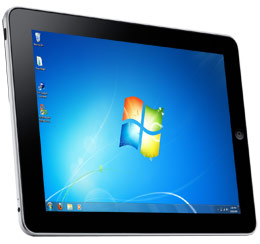Why I Want a Windows 7 Tablet -- And You Should, Too

For Microsoft, it is the best of times and the worst of times. A couple of weeks ago, the company announced it had sold 100 million copies of Windows 7 already. The 6-month-old OS is now installed on 10-percent of the world’s PCs and, by all accounts, is a huge success. And Redmond would seem to have plenty to look forward to, with the release of Office 2010 this quarter and devices running Windows Phone 7 due by end of the year.
So why are so many of Microsoft’s partners turning away from the company when it comes to mobile devices? Last week, we heard that HP may be trashing plans for its long-awaited Slate, supposedly because the company doesn’t think Windows 7 can work well enough on tablets. Even if it does release the device eventually, the Palo Alto company showed so little faith in Microsoft’s mobile strategy that it decided to acquire Palm. Perhaps they were reading some of the pundits.
PCMag Editor-in-Chief Lance Ulanoff wrote last month that "if Microsoft and its partners hinder these new tablets with a full-blown OS and the standard world of ad-hoc Windows applications and utilities bought from non-homogenous sources, Apple and the iPad will win." After the product’s alleged cancellation, ZDNet’s Jason Perlow was tougher calling the HP Slate “an ugly baby with Windows 7.” Even our own Mark Spoonauer recently referred to Windows 7 as too “resource and power-hungry” for tablets.
Intel hasn’t been much kinder than HP. Today, the chip-maker unveiled its new Atom Z6xx chipset for tablets and announced support only for Android and its own Moblin OS. That’s the first time we can remember an Intel chip that didn’t work with Windows (at least since the XScale days). If Intel doesn’t change its stance, it’s providing a strong disincentive for OEMs that want to make Windows 7 tablets and MIDs.
MSI, for example, recently told Engadget that they were delaying its dual screen tablet until Q4, because they’re looking for ways to get more endurance. On test units powered by a current-generation Atom Z5xx (Menlow) CPU, MSI said they were getting only 3 hours of battery life. It looks like, if they want the long battery life Intel’s new Atom Z6xx series chip provides, they’ll need to drop Windows 7 like a bad habit.
What HP, Intel, and the pundits can’t see is that Windows 7 actually has the potential to not only contend in this new tablet arena, but to dominate it. They just need to provide the right hardware and software to go with it.
I have the greatest respect for the iPad and its iPhone OS, but what if I want to use the exact same programs I enjoy on my desktop while I’m relaxing on my couch? What if I want to use the Web browser of my choice, and one that supports a full array of plug-ins, including Flash? What if I want to watch movies from Amazon Video On Demand or some other DRM-protected video store that isn’t iTunes? With the iPad, I’m out of luck. And what if I want to play World of Warcraft, instead of watered-down apps?
Stay in the know with Laptop Mag
Get our in-depth reviews, helpful tips, great deals, and the biggest news stories delivered to your inbox.
For that matter, what if I want to write or draw on my screen with a stylus? Windows 7 has excellent pen support, with handwriting recognition built right in.
I can sit wait and hope that Android or webOS matures enough to carry all the features and apps I could ever possibly want or I could use Windows 7, the world’s fastest growing and best supported operating system.
I don’t deny that Windows 7 has some issues when it comes to touch. The Start Menu is really difficult to navigate with one’s finger and dragging windows around on a slate doesn’t make a ton of sense. However, it’s very easy to put a good touch UI on top of Windows (see HP’s Touchsmart or Lenovo’s SimpleTap) and, with the right desktop theme settings, widgets like the minimize / maximize / close buttons can be large enough to tap with ease. Microsoft could help out by providing some kind of a touch UI that users can activate or by at least making a touch-friendly theme available. It would also help if the company’s own applications – Microsoft Office 2010, for example – had features that took advantage of touch.
Don’t believe the hype about Windows 7 being too power hungry for consumer tablets. If a 10-inch, 2.5-pound netbook can get 10 hours of battery life while running Windows 7, then it’s more than possible to create a 7-inch or 9-inch slate tablet that gets strong endurance. Vendors will just have to innovate when it comes to design and users may have to initially accept a little more thickness, a larger battery, or a tad less endurance than they’d get with an iPad. But those trade-offs are imminently worthwhile when you consider the user experience.
The huge ecosystem behind Windows 7 is what makes it such a compelling choice for tablets, MIDs, and other devices that sit between a phone and a PC. Some critics have derided Microsoft for not having a Windows 7 app store, but with Windows the entire Internet is your app store.
Microsoft’s leadership position and many well-publicized foibles make it an easy target. But there’s a reason why Windows remains the world’s leading operating system.

